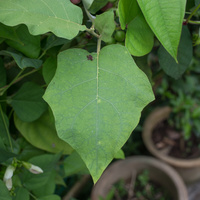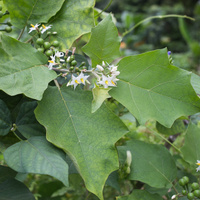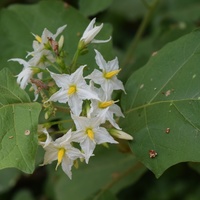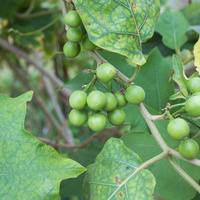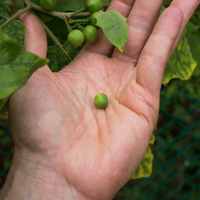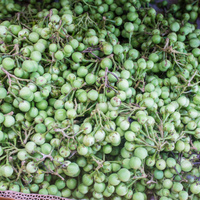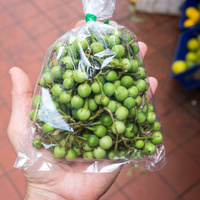Common name: Pea eggplant
Other common names: Devils fig, Gully bean, Sousumba, Susumber, Turkey berry, Wild eggplant
Description
Susumber (aka. Pea eggplant and Turkey berry) is an eggplant relative producing small, edible fruit cooked as a vegetable.
Native of Central and South America and the Caribbean, its natural range extends from Mexico to as far south as Brazil. Long introduced as a vegetable plant in other tropical regions, it is now widely cultivated in countries in Africa, Asia and the Pacific.
It is a fast-growing shrub or short-lived perennial, typically 1 to 3 m ( 3 to 10 ft) tall, occasionally up to 5 m (16 ft), with an erect central stem, off of which grown slim lateral branches.
The stems and branches are semi-woody, with thin green bark and a coating of fine hairs on young stems. On mature stems, the bark is light grey and dotted with raised pores (lenticels). Depending on the subspecies or variety, they are either armed with sharp spines or unarmed.
Leaves are broadly oval or heart-shaped 7.5 to 20 cm (3 to 8 in) long, smooth or lobed on the margins, on the top dull green, underneath grey-green, and finely hairy. They are arranged in pairs or singularly along the branches and remain on the plant in all seasons.
The flowers are small with five sharply-pointed white petals and yellow centres, borne in clusters at the sides of the branches. They bloom on and off throughout the year but are at their fullest from spring through summer. Fertilised flowers develop into small, round, fleshy fruit, 1 to 1.5 cm (0.4 to 0.6 in) in diameter. These are green when young, yellow or orange-red when ripe and with many tiny, brown, disc-shaped seeds inside.
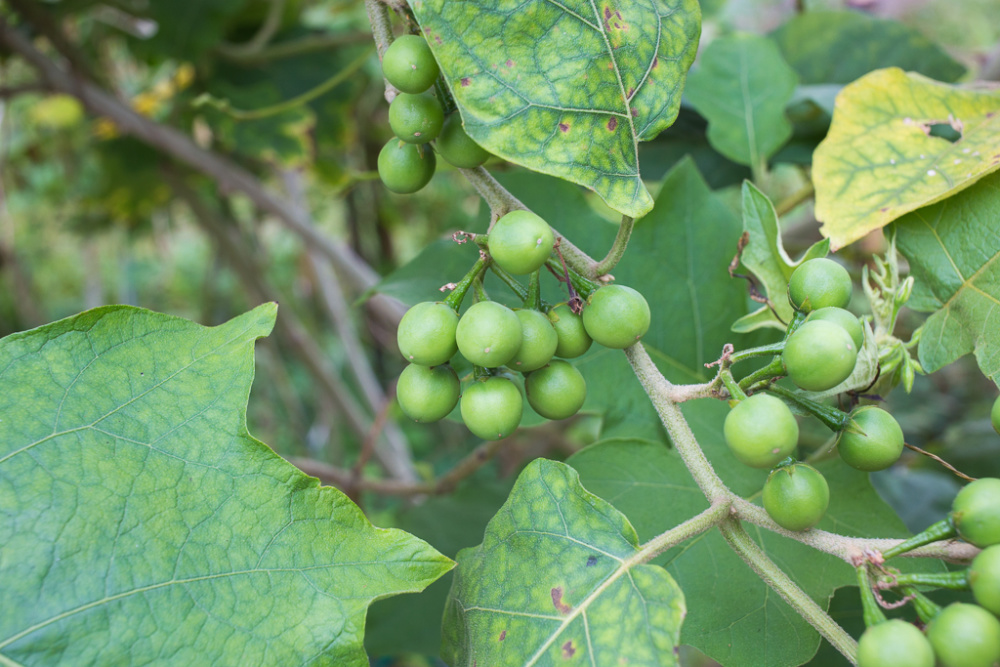
Use
The mature but still unripe or green fruit are added whole or sliced to Thai curries, Indian curries, and similar coconut-milk-based fish, meat and vegetable dishes in its native range. They have an earthy, slightly bitter flavour, similar to eggplant and remain semi-firm after cooking, adding a meaty texture. Their small round size and green colour resemble green peas, adding visual interest to dishes.
Seedlings plants are suitable rootstock for grafting on Eggplant (Solanum melongena) to overcome issues of eggplant susceptibility to Bacterial wilt and Fusarium wilt.
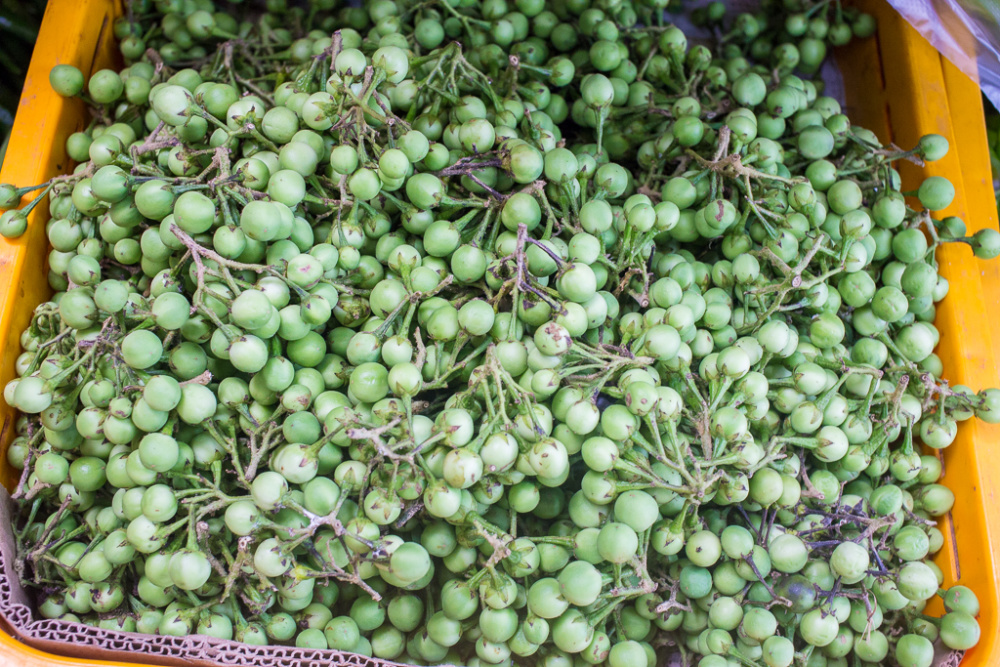
For sale at the market in Singapore
Climate
Grows naturally as perennial in moderately humid to very humid subtropical and tropical climates, generally frost-free areas with annual lows of 14 to 25°C, annual highs of 22 to 37°C, annual rainfall of 700 to 4500 mm and a dry season of 7 months or less, extending to drier areas with irrigation.
In Jamaica, it grows at elevations from near sea level up to 1200 meters (4000 feet), in areas where the average low of the warmest month is 17°C (63°F) or above.
Susumber may also persist as an annual in colder climates, such as in Mid and Northern Texas, in the United States.
Growing
Although new plants quickly grow from seed, a significant amount of the harvest in its native range comes from wild plants germinating and growing from bird-dispersed seed. The plants are mostly encountered on disturbed soils along roadsides or in open fields or paddocks, where there is enough sunlight to encourage growth.
Performs best on rich, free-draining loam and sand soil of a moderately acid to alkaline nature, generally with a pH of 5.0 to 8.0, and on sites with full to partial sun exposure. It has good tolerance to drought and limestone soils.
Problem features
Birds eat the fruit and disperse the seed afar. It is reported as a serious weed and invasive species in more than one country. It is prohibited from cultivation in Florida and is assessed as a high weed risk species for Hawaii by the Hawaii Pacific Weed Risk Assessment (HPWRA) project.
Where it grows
References
Books
-
Adams, C. D. 1972, Flowering plants of Jamaica, University of the West Indies, Mona, Greater Kingston
-
Francis, J. K. 2004, Wildland shrubs of the United States and its territories: Thamnic descriptions, U.S. Department of Agriculture, Forest Service, International Institute of Tropical Forestry, Río Piedras, San Juan, Puerto Rico & Rocky Mountain Research Station, Fort Collins, Colorodo
-
Higman, B. W 2008, Jamaican food : history, biology, culture, University of the West Indies Press, Kingston, Jamaica
-
Jacquat, C. & Bertossa, G. 1990, Plants from the markets of Thailand : descriptions and uses of 241 wild and cultivated plants, with 341 colour photographs, Editions Duang Kamol, Bangkok
-
Little, E. L. 1974, Trees of Puerto Rico and the Virgin Islands, Vol. 2, United States Department of Agriculture (USDA), Washington D.C.
-
Martin, F. M., et al. 1987, Perennial edible fruits of the tropics : an inventory, U.S. Dept. of Agriculture (USDA), Agricultural Research Service, U.S. Government Printing Office (GPO), Washington, D.C.
-
Parrotta, J. A. 2001, Healing plants of peninsular India, CABI Publishing, Wallingford, Oxfordshire
-
Randall, R. P. 2002, A global compendium of weeds, R.G. and F.J. Richardson Press, Melbourne
-
Randall, R. P. 2007, The introduced flora of Australia and its weed status, Cooperative Research Centre for Australian Weed Management, Glen Osmond, South Australia
-
Standley, P. C. 1920, Trees and shrubs of Mexico, Government Printing Office (GPO), Washington D.C.
-
Staples, G. & Kristiansen, M. S. 1999, Ethnic culinary herbs : a guide to identification and cultivation in Hawaii, University of Hawaii Press, Honolulu
Articles, Journals, Reports and Working Papers
-
Morton, J. F. 1976, Pestiferous spread of many ornamental and fruit species in south Florida. In Proceedings of the Florida State Horticultural Society (Vol. 89, pp. 348-353).
